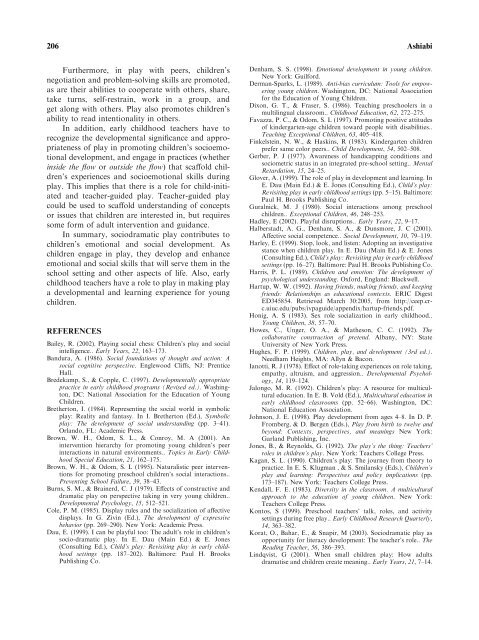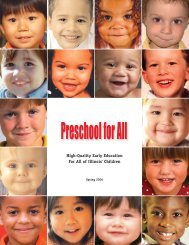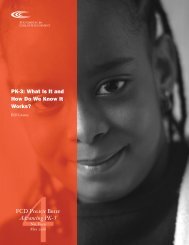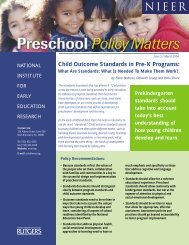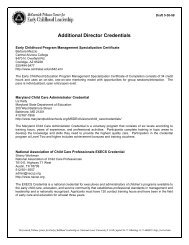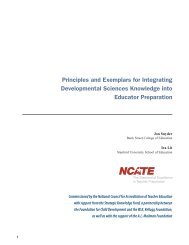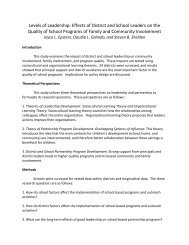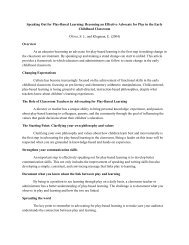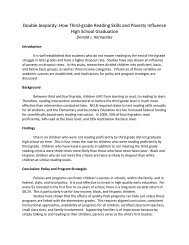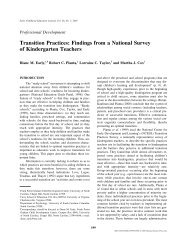Play in the Preschool Classroom - Leadership to INtegrate the Early ...
Play in the Preschool Classroom - Leadership to INtegrate the Early ...
Play in the Preschool Classroom - Leadership to INtegrate the Early ...
Create successful ePaper yourself
Turn your PDF publications into a flip-book with our unique Google optimized e-Paper software.
206 Ashiabi<br />
Fur<strong>the</strong>rmore, <strong>in</strong> play with peers, children’s<br />
negotiation and problem-solv<strong>in</strong>g skills are promoted,<br />
as are <strong>the</strong>ir abilities <strong>to</strong> cooperate with o<strong>the</strong>rs, share,<br />
take turns, self-restra<strong>in</strong>, work <strong>in</strong> a group, and<br />
get along with o<strong>the</strong>rs. <strong>Play</strong> also promotes children’s<br />
ability <strong>to</strong> read <strong>in</strong>tentionality <strong>in</strong> o<strong>the</strong>rs.<br />
In addition, early childhood teachers have <strong>to</strong><br />
recognize <strong>the</strong> developmental significance and appropriateness<br />
of play <strong>in</strong> promot<strong>in</strong>g children’s socioemotional<br />
development, and engage <strong>in</strong> practices (whe<strong>the</strong>r<br />
<strong>in</strong>side <strong>the</strong> flow or outside <strong>the</strong> flow) that scaffold children’s<br />
experiences and socioemotional skills dur<strong>in</strong>g<br />
play. This implies that <strong>the</strong>re is a role for child-<strong>in</strong>itiated<br />
and teacher-guided play. Teacher-guided play<br />
could be used <strong>to</strong> scaffold understand<strong>in</strong>g of concepts<br />
or issues that children are <strong>in</strong>terested <strong>in</strong>, but requires<br />
some form of adult <strong>in</strong>tervention and guidance.<br />
In summary, sociodramatic play contributes <strong>to</strong><br />
children’s emotional and social development. As<br />
children engage <strong>in</strong> play, <strong>the</strong>y develop and enhance<br />
emotional and social skills that will serve <strong>the</strong>m <strong>in</strong> <strong>the</strong><br />
school sett<strong>in</strong>g and o<strong>the</strong>r aspects of life. Also, early<br />
childhood teachers have a role <strong>to</strong> play <strong>in</strong> mak<strong>in</strong>g play<br />
a developmental and learn<strong>in</strong>g experience for young<br />
children.<br />
REFERENCES<br />
Bailey, R. (2002). <strong>Play</strong><strong>in</strong>g social chess: Children’s play and social<br />
<strong>in</strong>telligence.. <strong>Early</strong> Years, 22, 163–173.<br />
Bandura, A. (1986). Social foundations of thought and action: A<br />
social cognitive perspective. Englewood Cliffs, NJ: Prentice<br />
Hall.<br />
Bredekamp, S., & Copple, C. (1997). Developmentally appropriate<br />
practice <strong>in</strong> early childhood programs (Revised ed.). Wash<strong>in</strong>g<strong>to</strong>n,<br />
DC: National Association for <strong>the</strong> Education of Young<br />
Children.<br />
Bre<strong>the</strong>r<strong>to</strong>n, I. (1984). Represent<strong>in</strong>g <strong>the</strong> social world <strong>in</strong> symbolic<br />
play: Reality and fantasy. In I. Bre<strong>the</strong>r<strong>to</strong>n (Ed.), Symbolic<br />
play: The development of social understand<strong>in</strong>g (pp. 3–41).<br />
Orlando, FL: Academic Press.<br />
Brown, W. H., Odom, S. L., & Conroy, M. A (2001). An<br />
<strong>in</strong>tervention hierarchy for promot<strong>in</strong>g young children’s peer<br />
<strong>in</strong>teractions <strong>in</strong> natural environments.. Topics <strong>in</strong> <strong>Early</strong> Childhood<br />
Special Education, 21, 162–175.<br />
Brown, W. H., & Odom, S. L (1995). Naturalistic peer <strong>in</strong>terventions<br />
for promot<strong>in</strong>g preschool children’s social <strong>in</strong>teractions..<br />
Prevent<strong>in</strong>g School Failure, 39, 38–43.<br />
Burns, S. M., & Bra<strong>in</strong>erd, C. J (1979). Effects of constructive and<br />
dramatic play on perspective tak<strong>in</strong>g <strong>in</strong> very young children..<br />
Developmental Psychology, 15, 512–521.<br />
Cole, P. M. (1985). Display rules and <strong>the</strong> socialization of affective<br />
displays. In G. Ziv<strong>in</strong> (Ed.), The development of expressive<br />
behavior (pp. 269–290). New York: Academic Press.<br />
Dau, E. (1999). I can be playful <strong>to</strong>o: The adult’s role <strong>in</strong> children’s<br />
socio-dramatic play. In E. Dau (Ma<strong>in</strong> Ed.) & E. Jones<br />
(Consult<strong>in</strong>g Ed.), Child’s play: Revisit<strong>in</strong>g play <strong>in</strong> early childhood<br />
sett<strong>in</strong>gs (pp. 187–202). Baltimore: Paul H. Brooks<br />
Publish<strong>in</strong>g Co.<br />
Denham, S. S. (1998). Emotional development <strong>in</strong> young children.<br />
New York: Guilford.<br />
Derman-Sparks, L. (1989). Anti-bias curriculum: Tools for empower<strong>in</strong>g<br />
young children. Wash<strong>in</strong>g<strong>to</strong>n, DC: National Association<br />
for <strong>the</strong> Education of Young Children.<br />
Dixon, G. T., & Fraser, S. (1986). Teach<strong>in</strong>g preschoolers <strong>in</strong> a<br />
multil<strong>in</strong>gual classroom.. Childhood Education, 62, 272–275.<br />
Favazza, P. C., & Odom, S. L (1997). Promot<strong>in</strong>g positive attitudes<br />
of k<strong>in</strong>dergarten-age children <strong>to</strong>ward people with disabilities..<br />
Teach<strong>in</strong>g Exceptional Children, 63, 405–418.<br />
F<strong>in</strong>kelste<strong>in</strong>, N. W., & Hask<strong>in</strong>s, R (1983). K<strong>in</strong>dergarten children<br />
prefer same color peers.. Child Development, 54, 502–508.<br />
Gerber, P. J (1977). Awareness of handicapp<strong>in</strong>g conditions and<br />
sociometric status <strong>in</strong> an <strong>in</strong>tegrated pre-school sett<strong>in</strong>g.. Mental<br />
Retardation, 15, 24–25.<br />
Glover, A. (1999). The role of play <strong>in</strong> development and learn<strong>in</strong>g. In<br />
E. Dau (Ma<strong>in</strong> Ed.) & E. Jones (Consult<strong>in</strong>g Ed.), Child’s play:<br />
Revisit<strong>in</strong>g play <strong>in</strong> early childhood sett<strong>in</strong>gs (pp. 5–15). Baltimore:<br />
Paul H. Brooks Publish<strong>in</strong>g Co.<br />
Guralnick, M. J (1980). Social <strong>in</strong>teractions among preschool<br />
children.. Exceptional Children, 46, 248–253.<br />
Hadley, E (2002). <strong>Play</strong>ful disruptions.. <strong>Early</strong> Years, 22, 9–17.<br />
Halberstadt, A. G., Denham, S. A., & Dunsmore, J. C (2001).<br />
Affective social competence.. Social Development, 10, 79–119.<br />
Harley, E. (1999). S<strong>to</strong>p, look, and listen: Adopt<strong>in</strong>g an <strong>in</strong>vestigative<br />
stance when children play. In E. Dau (Ma<strong>in</strong> Ed.) & E. Jones<br />
(Consult<strong>in</strong>g Ed.), Child’s play: Revisit<strong>in</strong>g play <strong>in</strong> early childhood<br />
sett<strong>in</strong>gs (pp. 16–27). Baltimore: Paul H. Brooks Publish<strong>in</strong>g Co.<br />
Harris, P. L. (1989). Children and emotion: The development of<br />
psychological understand<strong>in</strong>g. Oxford, England: Blackwell.<br />
Hartup, W. W. (1992). Hav<strong>in</strong>g friends, mak<strong>in</strong>g friends, and keep<strong>in</strong>g<br />
friends: Relationships as educational contexts. ERIC Digest<br />
ED345854. Retrieved March 30:2005, from http://ceep.crc.uiuc.edu/pubs/ivpaguide/appendix/hartup-friends.pdf.<br />
Honig, A. S (1983). Sex role socialization <strong>in</strong> early childhood..<br />
Young Children, 38, 57–70.<br />
Howes, C., Unger, O. A., & Ma<strong>the</strong>son, C. C. (1992). The<br />
collaborative construction of pretend. Albany, NY: State<br />
University of New York Press.<br />
Hughes, F. P. (1999). Children, play, and development (3rd ed.).<br />
Needham Heights, MA: Allyn & Bacon.<br />
Ianotti, R. J (1978). Effect of role-tak<strong>in</strong>g experiences on role tak<strong>in</strong>g,<br />
empathy, altruism, and aggression.. Developmental Psychology,<br />
14, 119–124.<br />
Jalongo, M. R. (1992). Children’s play: A resource for multicultural<br />
education. In E. B. Vold (Ed.), Multicultural education <strong>in</strong><br />
early childhood classrooms (pp. 52–66). Wash<strong>in</strong>g<strong>to</strong>n, DC:<br />
National Education Association.<br />
Johnson, J. E. (1998). <strong>Play</strong> development from ages 4–8. In D. P.<br />
Fromberg, & D. Bergen (Eds.), <strong>Play</strong> from birth <strong>to</strong> twelve and<br />
beyond: Contexts, perspectives, and mean<strong>in</strong>gs New York:<br />
Garland Publish<strong>in</strong>g, Inc.<br />
Jones, B., & Reynolds, G. (1992). The play’s <strong>the</strong> th<strong>in</strong>g: Teachers’<br />
roles <strong>in</strong> children’s play. New York: Teachers College Press.<br />
Kagan, S. L. (1990). Children’s play: The journey from <strong>the</strong>ory <strong>to</strong><br />
practice. In E. S. Klugman , & S. Smilansky (Eds.), Children’s<br />
play and learn<strong>in</strong>g: Perspectives and policy implications (pp.<br />
173–187). New York: Teachers College Press.<br />
Kendall, F. E. (1983). Diversity <strong>in</strong> <strong>the</strong> classroom. A multicultural<br />
approach <strong>to</strong> <strong>the</strong> education of young children. New York:<br />
Teachers College Press.<br />
Kon<strong>to</strong>s, S (1999). <strong>Preschool</strong> teachers’ talk, roles, and activity<br />
sett<strong>in</strong>gs dur<strong>in</strong>g free play.. <strong>Early</strong> Childhood Research Quarterly,<br />
14, 363–382.<br />
Korat, O., Bahar, E., & Snapir, M (2003). Sociodramatic play as<br />
opportunity for literacy development: The teacher’s role.. The<br />
Read<strong>in</strong>g Teacher, 56, 386–393.<br />
L<strong>in</strong>dqvist, G (2001). When small children play: How adults<br />
dramatise and children create mean<strong>in</strong>g.. <strong>Early</strong> Years, 21, 7–14.


